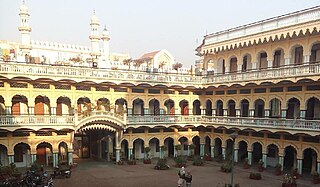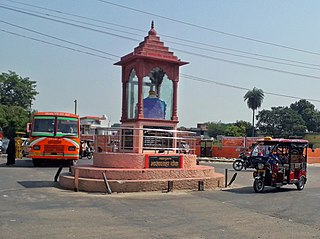
Meerut is a city in Meerut district of the western part of the Indian state of Uttar Pradesh. The city lies 80 km (50 mi) northeast of the national capital New Delhi, within the National Capital Region and 480 km (300 mi) west of the state capital Lucknow.

Bareilly is a city in Bareilly district in the Indian state of Uttar Pradesh. It is among the largest metropolises in Western Uttar Pradesh and is the centre of the Bareilly division as well as the historical region of Rohilkhand. The city lies in the Indo-Gangetic Plains, about 252 kilometres (157 mi) northwest of the state capital, Lucknow, and 265 kilometres (165 mi) east of the national capital, New Delhi. With a population of 903,668 in 2011, it is the eighth most populous city in the state, 17th in northern India and 54th in India. It is located on the bank of Ramganga River and is the site of the Ramganga Barrage built for canal irrigation.

Saharanpur is a city and a municipal corporation in Uttar Pradesh, India. It is also the administrative headquarters of Saharanpur district.

Rohillas are a mixed Indian community of Pashtun heritage, historically found in Rohilkhand, a region in the state of Uttar Pradesh, India. It forms the largest Pashtun diaspora community in India, and has given its name to the Rohilkhand region. The Rohilla military chiefs settled in this region of northern India in the 1720s, the first of whom was Ali Mohammed Khan.

Moradabad is an industrial city, commissionerate, and municipal corporation in Moradabad district of the Indian state of Uttar Pradesh. It is situated on the banks of the Ramganga river, at a distance of 167 km (104 mi) from the national capital, New Delhi and 344 km north-west of the state capital, Lucknow. Based on the 2011 census, it is 10th most populous city in the state and 54th most populous city in the country. It is one of the largest cities in the Western UP region, serving as a crucial hub for employment, education, industry, culture, and administration.

Budaun is a medieval city and headquarters of Budaun district, in the Indian state of Uttar Pradesh. It is located about a mile east of the Sot river, and 27 km north of the Ganges, in the Rohilkhand region of Uttar Pradesh. According to the 2011 census, it has a population of 159,221, which is projected at 161,555 at present. Budaun rose to historical importance as the capital of the Delhi Sultanate for four years from 1210 CE to 1214 CE during the reign of Sultan Iltutmish. It was the most important post of Northern Frontier during Mughal reign. Budaun is a big market, historically famous and religiously important city. Budaun is 230 km south-east of New Delhi and 245 km north-west of Lucknow, both taking about 6 hours by road.

The Bareilly district belongs to the state Uttar Pradesh in northern India. Its capital is Bareilly city and it is divided in six administrative division or tehsils: Aonla, Baheri, Bareilly city, Faridpur, Mirganj, and Nawabganj. The Bareilly district is a part of the Bareilly Division and occupies an area of 4120 km2 with a population of 4,448,359 people according to the census of 2011.

Bijnor district is one of the 75 districts in the state of Uttar Pradesh in India. Bijnor city is the district headquarters. The government of Uttar Pradesh seeks its inclusion in National Capital Region (NCR) due to its close proximity to NCT of Delhi.

Mahoba district is a district of the Indian state of Uttar Pradesh. Headquartered in the city of Mahoba, the district had a population of a population of 875,958 as of the 2011 Indian census and occupies 2884 km2 within the Chitrakoot division of Uttar Pradesh. As of 2011 it was the least populous district of Uttar Pradesh. Mahoba District is also known as Alha-Udal Nagari.

Moradabad district is one of the districts of Uttar Pradesh, India. The city of Moradabad is the district headquarters. Moradabad district is part of Moradabad division. It used to be the second most populous district of Uttar Pradesh out of 75 after Prayagraj till a new district Sambhal was carved out of it in 2011.
Nagina is a town and a municipal board in Bijnor district in the Indian state of Uttar Pradesh.
Najibabad is a town in the Bijnor district of the Indian state of Uttar Pradesh, located near the city of Bijnor. It is a major industrial centre and has national transport links via rail and roadways such as NH 119 and NH 74.
Chandpur is a town and a municipal board in Bijnor district in the Indian state of Uttar Pradesh, India.
Kiratpur, also known as Basi Kiratpur, is a town and a Municipal Board in Bijnor district of Uttar Pradesh.
Noorpur is a City and a Municipal Board in Bijnor District in the Indian State of Uttar Pradesh.

Hindon River is an Indian river in that originates from the Shakumbhari devi range in Saharanpur district of Uttar Pradesh and falls into Yamuna river in Noida. Hindon is a tributary of Yamuna and is entirely rainfed, having an approximate catchment area of 7,083 square kilometres (2,735 sq mi).
The Government of Uttar Pradesh is the subnational government of the Indian state of Uttar Pradesh with the governor as its appointed constitutional head of the state by the President of India. The Governor of Uttar Pradesh is appointed for a period of five years and appoints the Chief Minister of Uttar Pradesh and their council of ministers, who are vested with the executive powers of the state. The governor remains a ceremonial head of the state, while the chief minister and their council are responsible for day-to-day government functions.
Alamgirpur is an archaeological site of the Indus Valley civilization that thrived along Yamuna River from the Harappan-Bara period, located in Meerut district, Uttar Pradesh, India. It is the easternmost known site of the civilization.

Western Uttar Pradesh is a region in India that comprises the western districts of Uttar Pradesh state, including the areas of Rohilkhand and those where Hindi and Braj are spoken. The region has some demographic, economic and cultural patterns that are distinct from other parts of Uttar Pradesh, and more closely resemble those of Haryana and Rajasthan states. The largest city of the region is Ghaziabad, while the second-largest city, Agra, is a major tourist destination.
Barhapur Assembly constituency is one of the 403 constituencies of the Uttar Pradesh Legislative Assembly, India. It is a part of the Bijnor district and one of the five assembly constituencies in the Moradabad Lok Sabha constituency. First election in this assembly constituency was held in 2012 after the "Delimitation of Parliamentary and Assembly Constituencies Order, 2008" was passed in the year 2008.















